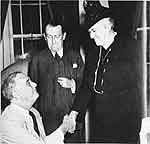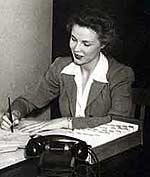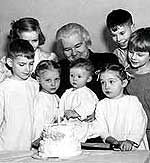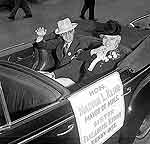By Dan Olson
Minnesota Public Radio
August 22, 2002
| |
|
|
|
||
Elizabeth Kenny was famous. However, not many people knew much about the woman.
"We never really knew what Sister's age was," said Margaret Ernest, Kenny's office administrator. Ernest, now retired, lives in Minneapolis.
Elizabeth Kenny was born in 1880, although she told people it was 1886, Ernest said. She was a formidable figure.
"Broad and big-busted, and she carried herself ... like a queen," Ernest said.
Kenny was 59 when she arrived in Minneapolis in 1940. Ernest said she was a workaholic.
"It just seemed like she required very little rest. She was always up early in the morning and ready to go, and she'd be calling people at ungodly hours," Ernest said.
Kenny's caseload rose with polio's rising toll. Evelyn and Edwin Hande's children became part of Kenny's caseload. They were returning from a vacation in 1950 when their sone, 6, and their daughter, 2, showed polio symptoms.
| |
|
|
|
||
"He was kind of lounging in the back seat during the whole trip back, and when we got home, our little girl, who was just learning to walk, couldn't walk anymore," Evelyn Hande said.
They immediately took the children to Minneapolis General Hospital, already crammed with children paralyzed with polio.
"One of the doctors said, 'We don't have any room for you.' And the other doctor said, 'We gotta take them in,' so they were put in the hallways," Edwin Hande said.
The Hande children were isolated with hundreds of other polio victims. The Handes despaired.
"We couldn't get to see them, we couldn't do anything about it. It was a worrisome time. We were just sad," Evelyn Hande said.
They said neighborhoods and families closed their doors.
"People weren't going to church, they weren't going anyplace. And I don't think anybody wanted to talk to us," Evelyn said.
| |
|
|
|
||
Edwin says panic was rife among parents, because so many of polio's victims were children.
"If you think about anthrax today, just think about what polio was then. Unbelievable. People were scared," he said.
The Hande children made a complete recovery.
Doctors still groused, sometimes publicly, about Elizabeth Kenny's ideas. But many muzzled their criticisms and adopted her techniques. After all, they were yielding dramatic results, and, more importantly, invoking the Kenny name was a potent source of money for polio treatment and research into a vaccine.
A vaccine to stop polio became widely available in 1955. Until then, the Kenny method was still the best thing going to treat the disease.
Decades of nearly non-stop medical work, fundraising and lobbying had taken a toll. Elizabeth Kenny was sick. Parkinson's disease was eroding her vitality. She left the United States and returned to her hometown in northern Queensland, Australia, where she lived the last years of her life. Elizabeth Kenny died in 1952.
|
"Every patient I talk to who was treated as a child says to me, 'I was her favorite.'... She had some real gifts as a nurse, because every person she physically touched or was involved with felt very special."
- Dr. Jennine Speier, director of Kenny Rehabilitation Services |
Kenny's ideas are still in use around the world, and at Abbott Northwestern Hospital in Minneapolis. Victims of vehicle crashes, stroke and others who've lost use of their limbs receive muscle re-education at Kenny Rehabilitation Services.
Director Dr. Jennine Speier said Kenny's use of her hands - fingers probing muscles weakened by polio for any sign of life - advanced understanding of how to help convince patients they can move.
"If the muscle has to lift the whole leg, and the leg is partially paralyzed and heavy, you can't really do very much. But if you put your hands there and support it, suddenly that muscle will kick in," Dr. Speier said. "I think Sister Kenny was doing this, but when she started she probably didn't even know what stretch receptors were."
Dr. Jennine Speier is too young to have met or worked with Elizabeth Kenny. But Speier occasionally treats some of Kenny's former patients. Their memory of Kenny, she said, reminds her of the power a health care worker's attitude can have on a patient.
| |
|
|
|
||
"Every patient I talk to who was treated as a child says to me, 'I was her favorite.' So, you have to say she had some real gifts as a nurse, because every person she physically touched or was involved with felt very special," Speier said.
Yale University history professor Naomi Rogers says Kenny's singular personality sets her apart as one of the most compelling figures of her time.
"(She was) a feisty, large, almost overbearing woman, with gentle hands and a special understanding of a very frightening disease," Rogers said.
Even today, polio is still a scourge in some parts of the world - with outbreaks in central Africa and India. Elsewhere, polio is a disease of the past. Public health officials predict its eradication in a few years.
Fifty years ago, at the height of the polio epidemic in this country, thousands of polio victims regained mobility because of Elizabeth Kenny's ideas. A few medical histories note her role. There's a small museum in her hometown in Australia.
But her most visible legacy is in Minneapolis, where a neighborhood, a school and a hospital rehabilitation center are named after her.
More from MPR



